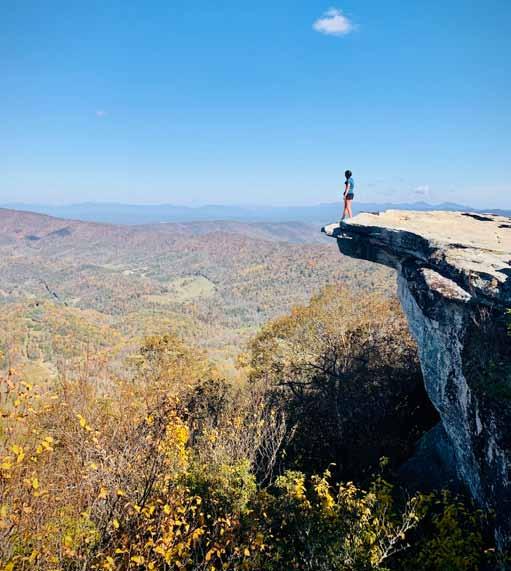
7 minute read
GoHike
A BOUTIQUE SHOP

Advertisement
Men’s & Women’s Clothing and Swimwear Great Outlet Selection 252-261-1650

At the Waterfront Shops in Duck Shop barreestation.com
33 Years of Kindness & Community Spirit
27 YEARS
252.261.0224 • SteamersOBX.com
1 Ocean Boulevard, Southern Shores Southern Shores Crossing Shopping Center
“Hey! You can’t see your house from here!” Photo: Stephanie Hall
THe greatest esCape
Local ladies find their mountain legs on the Appalachian Trail
Stephanie Hall couldn’t find her friend.
Huddled in the dense Shenandoah National Forest, she crouched low to the ground as the torrential rains and winds of Hurricane Delta tore through the mountains. It grew darker, the temperature dropped, and she knew the chances of hypothermia would increase if she didn’t take shelter. After pitching her tent as much out of the wind as she could, she climbed inside and attempted to rest.
“Of course, everything was calm again in the morning,” Hall laughs. “I started looking for her, and it turned out she’d pitched her own tent less than a mile away.”
That’s just one of the countless adventures the 27-year-old KDH resident encountered while completing the Appalachian Trail last fall. She left for her trek on August 5. Starting out from its northernmost point in Katahdin, Maine, she made her way south with nothing but a backpack. She finished up on Springer Mountain, Georgia, on November 18 — 2,190 miles later.
The trail typically takes about five to seven months to complete from start to finish. Hall, however, did it all in 105 days — about three-and-a-half months.
While friends and family met her along the way to hike for a few days at a clip, for the most part, she was on her own. That allowed for a rapid pace. She averaged 21plus miles per day. Some days were shorter. (Hurricanes made getting anything over ten miles a challenge.) And others were longer. (One “marathon week,” she walked at least 26 miles every day.)
“I started telling people, ‘I want to be home by Thanksgiving,’” Hall says, then laughs, “I had no idea what I was getting myself into.”
But she certainly knew why. She got the idea while talking to an older man who’d hiked portions of the trail when he was younger.
“I mentioned that I was thinking of hiking it. He was like, ‘You can’t do it … you’re a woman.’”
From there, conquering “the AT” became part physical challenge, part personal mission. Backpacking was new to Hall, and she wanted an experience that pushed her body to the limits. There was also the urge to prove to others that she could do it herself, though she took comfort in the company of others whenever possible — whether visiting friends or fellow travelers.
“Definitely some parts of me were scared, but the trail draws such a great community,” Hall says. “If I met any weird hikers, I just kept to myself and kept on going.”
Every week and a half, she stayed in a hostel for a fresh shower and laundry. Beyond that, she camped or spent the night in shelters, if they had space. If they were full, Hall pressed on.
“You have to get in this mindset of, ‘Why am I out here? What are my goals?’ and just keep repeating it to yourself,” she says.
Unlike Hall, most people hiking the entire AT opt for the easier northbound route. (Apparently, there’s an easy way to hike 2,190 miles.) They start in Georgia in March or April and head northward. This gives them time to develop their trail legs by the time they reach the towering peaks in New England.
But, rarely can hikers dedicate half a year to completing the trail, so they do it in pieces. Brandy Foard and Cindy Jones fall into this category. The duo has hiked various sections since 2014, focusing on trails in North Carolina and Virginia. They head westward a few weekends each year and go 30-or-so miles at a time. One, prior to first starting the trail, was a trip to Harper’s Ferry, West Virginia. While there, the friends met a couple of thru-hikers who spoke of the trail’s wild environment and brimming challenges. It instantly intrigued the women. They read up and planned their first hike, packed their bags (too full, as Jones recalls) and ventured out for a three-day hike, going 15 miles a day. Between mileage and baggage (Jones’ pack weighed 50 lbs.), they instantly identified what to tweak for future trips.
“We knew the first time we’d be making a whole lot of mistakes,” Jones says. “Even though it’s tough, I still loved it. I wanted to get better at it.”
Now, they piece out hikes in seven-mile days and have invested in lightweight gear. The mix of sudden thrills and natural beauty mesmerizes the women each time.
“It’s just so rewarding,” Jones says. “The views, the mountains rising, the sun coming through the trees. The unexpected aspect makes it beautiful, like you really don’t know what’s around the corner.”
Foard agrees: “You just have to go out into the wilderness to experience that sort of thing.”
Once you do, it’s impossible to forget. Weeks after returning, Hall can still recount every detail. The freeing feeling of leaping into a mountain lake on a hot day. Hiking the White Mountains, which cover a third of New Hampshire. Scarfing down gallons of ice cream to replace thousands of calories she burned per day. She waxes on and on, each step and memory adding up to the ultimate escape.
“Physically, I’m still here,” she laughs. “But mentally I’m still on the trail.” — Hannah Lee Leidy
“one “marathon Week,” hall Walked at least 26 mIles eaCh daY. KNOW BEFORE YOU GO:
Wanna tackle the AT? Hall, Foard and Jones offer top advice for researching, packing for, and executing a hike:
Getting Prepped
• Hall mapped out her hike and researched her plans using books, YouTube videos, podcasts, and Facebook Groups. She also tried to go on regular runs while wearing her pack. • Foard and Jones researched using the book Exploring the Appalachian Trail, which features hiking guides for varying abilities. They trained at the Wright Brothers
National Monument, walking up and over the hill as many times as possible.
Packing
• For long-term hikers, traveling light is key. Hall’s backpack had an ultralight “base weight” of 11.3 pounds, including sleeping bag, tent and other essentials — but without food and water — which helped her fast pace. Before starting the trail, she recommends serious hikers get a “shakedown”, where an experienced hiker goes through their bags and remove unnecessary gear. • Foard and Jones, along with other short-term hikers, can afford to indulge in a few creature comforts from home — like boxed wine to toast the end of each day. Still,
Jones recommends investing in choice pieces of lightweight gear, depending on how frequently, and how seriously, you plan to hike.
Best Thing to Bring
• Hall credits her Zpack blanket for getting her through those 20-degree nights. • Jones got her backpack specially fitted at REI, and it’s now her prize piece of gear.
Helpful Additions
• Ibuprofen/low-grade painkiller • Band-Aids • Superglue • Emergency sewing kit • Heat source to cook food (Pros: Hot meals! Hot coffee! Cons: Heavy; requires fuel.) • A small container to cold-soak food (if not using a heat source). An old Talenti pint was Hall’s weapon of choice.
Things to Leave Home
• Hall: “Anything that requires batteries.” • While Foard loves bringing along portable French-press coffee cups, she admits they may not be necessary for long-term hikers. “Since we’re only out there a few days at a time, we’re pretty bougie about it,” Foard laughs.
Hiker Slang
NoBo: A North-Bound Hiker SoBo: A South-Hound Hiker Trail Angels: People who help hikers along the way, whether by offering rides, leaving extra food at shelters, or pain relief when needed. Trail Name: Leave your identity behind and accept the new name the trail gives you.
Hall’s was Puffin, and she referred to a friend as Armadillo. It’s unclear if either know each other’s actual names. Tramily: Your trail family: people you meet along the way, befriend and hike with.
“One of the best parts is all the thru-hikers you meet along the way,” Jones says. “Hike your own hike”: A hiker’s way of saying, “Be self-sufficient.”




